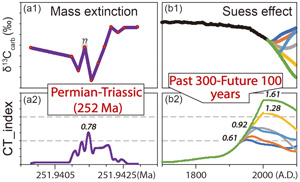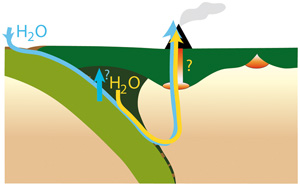 | In situ redox control and Raman spectroscopic characterisation of solutions below 300 °C Abstract: Redox reactions often occur and significantly affect many geological processes. To simulate redox reactions in low temperature (T < 400 °C) hydrothermal experiments, fused silica was used as a hydrogen membrane to impose an externally fixed H2 pressure (PH2) on a fused silica capillary capsule (FSCC; 150 μm inner diameter, 375 μm outer diameter and ∼6 mm long) to define the redox state of the sample in the FSCC. At 300 °C, it required less than 7 hours to reach osmotic equilibrium. In this study, a constant PH2 was imposed on an FSCC, which originally contained a 0.5 m (mole/kg H2O) SnCl4 + 0.5 m HCl aqueous solution, at 300 °C and vapour saturation pressure. In situ Raman spectra of the sample solution collected at 300 °C show that the reduction rate of SnIV to SnII species increased substantially with an increase of 1.1 bar of PH2. We characterised precipitation and dissolution of cassiterite under various P-T-pH-PH2 conditions and greatly increased our capabilities for performing rigorous hydrothermal experiments at temperatures below 400 °C, in which redox control is difficult to ensure without in situ approaches. |
 | Early differentiation of magmatic iron meteorite parent bodies from Mn–Cr chronometry Abstract: Magmatic iron meteorite groups such as IIAB, IIIAB and IVA, represent the largest sampling of extraterrestrial core material from the earliest accreted distinct planetary bodies in the solar system. Chromium isotope compositions of chromite/daubréelite from seven samples, translated into 53Cr/52Cr model ages, provide robust time information on planetary core formation. These ages are within ∼1.5 Ma after formation of calcium-aluminium-rich inclusions (CAIs) and define the time of metal core formation in the respective parent bodies, assuming metal–silicate separation was an instantaneous event that induced strong chemical fractionation of Mn from the more siderophile Cr. The early core formation ages support accretion and differentiation of the magmatic iron meteorite parent bodies to have occurred prior to the chondrule formation interval. The calibration of Mn–Cr ages with established Hf–W ages of samples from the same magmatic iron meteorite groups constrains the initial ɛ53Cr of the solar system to −0.30 ± 0.05, and thus lower than previously estimated. |
 | A novel carbon cycle turbulence index identifies environmental and ecological perturbations Abstract: Earth’s history has been characterised by complex interactions between life and the environment, which are often difficult to resolve. Here, we propose a new carbon cycle turbulence index (CTindex), based on the carbonate-carbon isotope (δ13Ccarb) record, to measure the extent of environmental perturbation over the last billion years. The CTindex trend is closely linked to Phanerozoic biotic extinction rates (ERs), as calculated from a palaeobiology database, supporting a strong environmental control on biotic ERs. We use the empirical CTindex—ER relationship to compare the extent of environmental perturbation due to greenhouse gas emissions with that during the Permian-Triassic (PTr) transition (∼252 Ma), representing the most severe mass extinction of the Phanerozoic. At the current peak of fossil fuel emissions, the CTindex indicates a moderate future environmental perturbation. However, if fossil fuel emissions increase into the next century, a pronounced CTindex peak greater than that which occurred during the PTr transition is indicated, which suggests the potential for a severe “sixth mass extinction” in the future. |
 | Comment on “190Pt-186Os geochronometer reveals open system behaviour of 190Pt-4He isotope system” by Luguet et al. (2019) |
 | Reply to Comment on “190Pt-186Os geochronometer reveals open system behaviour of 190Pt-4He isotope system” by Yakubovich et al. (2022) |
 | Slab dehydration beneath forearcs: Insights from the southern Mariana and Matthew-Hunter rifts Abstract: The water flux delivered into the forearc mantle of currently active subduction zones remains poorly constrained. Estimates, which mostly derive from numerical modelling, have so far been untested, as shallow subduction processes are hindered by the serpentinised forearc mantle. Here, I examine the composition of near trench magmas from the southern Mariana and Matthew-Hunter rifts, which provides unique glimpses into slab dehydration underneath the forearcs of two modern subduction zones. The near trench magmas captured the water-rich slab fluids that usually serpentinise the cold forearc mantle. The near trench magmas possess higher markers in slab dehydration (Rb/Th = 3–141, Cs/Th = 0.04–17.79, H2O/Ce = 436–23,531) than do arc and back-arc magmas, implying that the subducted plates might dehydrate efficiently within 80 km from the trench. |
 | Nitrogen isotope fractionation during magma ocean degassing: tracing the composition of early Earth’s atmosphere Abstract: The evolution of the nitrogen concentration and isotopic composition during the degassing of Earth’s magma ocean, and thus in the primitive atmosphere, is key to understanding how habitable conditions developed on Earth. To constrain nitrogen degassing from the magma ocean, we determined the variations of the N content at N2 gas saturation, N speciation, and N isotopic composition of a magma ocean analogue (basaltic komatiite) at oxygen fugacities (fO2) from IW−4.2 to IW (where IW is the logarithmic difference between experimental fO2 and that at Fe-FeO equilibrium). We performed a series of N degassing experiments in a piston cylinder at 1.5 GPa and 1550 °C in pure forsterite capsules. N concentrations in the mafic silicate melts decreased from 13,481 ± 735 ppm under the most reducing conditions to 798 ± 4 ppm at IW, controlled by N speciation (as determined by Raman spectroscopy), which changed from nitride (±N-H complexes) to molecular N2 with increasing fO2. Nitrogen occurs solely as N2 in the degassed gas, regardless of fO2. Nitrogen isotopic compositions (as determined by secondary ion mass spectroscopy) became significantly lighter in the degassed melt (quenched glass), down to −41 ± 13 ‰ relative to the initial composition (measured in an undegassed sample), following open system degassing trends (variable with fO2 conditions), indicative of Rayleigh fractionation. These findings imply that an atmosphere in equilibrium with a reduced magma ocean would be N-depleted, whereas with increasing magma ocean fO2 conditions, the primitive atmosphere would have become more enriched in N2 gas. |
 | Oxidation of La Réunion lavas with MORB-like fO2 by assimilation Abstract: Oxygen fugacity (fO2) is poorly constrained in mantle reservoirs, especially those sampled by ocean island basalts (OIBs). This is partly due to complications from secondary processes acting on fO2 in OIB parental magmas. To investigate these issues in situ trace element data of olivine in lavas from the island of La Réunion are reported. La Réunion lavas are useful for examining post-melting modification due to their limited range in isotopic signatures, indicating a largely homogenous mantle source. Vanadium abundances in olivine were used to constrain the lava fO2 to between +0.2 and +1.5 ΔFMQ, intermediate between that of mid-ocean ridge basalts (MORBs) and other OIBs. The variable fO2 of Réunion lavas results from assimilation processes within the volcanic edifice, and not source heterogeneity. The Réunion mantle plume likely has fO2 similar to that of MORB, despite isotopic evidence for the plume sampling an early-formed isolated mantle reservoir. Assimilation processes can have a pronounced effect on lava fO2 and should always be accounted for when constraining mantle redox. |
 | Experiments reveal enrichment of 11B in granitic melt resulting from tourmaline crystallisation Abstract: Tourmaline is the most common boron-rich mineral in magmatic systems. In this study, we determined experimentally the fractionation of boron isotopes between granitic melt and tourmaline for the first time. Our crystallisation experiments were performed using a boron-rich granitic glass (B2O3 ≈ 8 wt. %) at 660−800 °C, 300 MPa, and aH2O = 1, in which tourmaline occurs as the only boron-hosting mineral. Our experimental results at four different temperatures show a small and temperature-dependent boron isotope fractionation between granitic melt and tourmaline (Δ11Bmelt–Tur = +0.90 ± 0.05 ‰ at 660 °C and +0.23 ± 0.12 ‰ at 800 °C), and the temperature dependence can be defined as Δ11Bmelt–Tur = 4.51 × (1000/T [K]) − 3.94 (R2 = 0.96). Using these boron isotope fractionation factors, tourmaline can serve as a tracer to quantitatively interpret boron isotopic ratios in evolved magmatic systems. Our observation that 11B is enriched in granitic melt relative to tourmaline suggests that the δ11B of late-magmatic tourmaline should be higher than tourmaline that crystallised at an early stage, if B isotope fractionation is not affected by other processes, such as fluid loss. |
 | The end of the isotopic evolution of atmospheric xenon Abstract: Noble gases are chemically inert and, as such, act as unique tracers of physical processes over geological timescales. The isotopic composition of atmospheric xenon, the heaviest stable noble gas, evolved following mass-dependent fractionation throughout the Hadean and Archaean aeons. This evolution appears to have ceased between 2.5 and 2.1 Ga, around the time of the Great Oxidation Event (GOE). The coincidental halting of atmospheric Xe evolution may provide further insights into the mechanisms affecting the atmosphere at the Archaean-Proterozoic transition. Here, we investigate the isotopic composition of Xe trapped in hydrothermal quartz from three formations around the GOE time period: Seidorechka and Polisarka (Imandra-Varzuga Greenstone Belt, Kola Craton, Russia) with ages of 2441 ± 1.6 Ma and 2434 ± 6.6 Ma, respectively, and Ongeluk (Kaapvaal Craton, South Africa) dated at 2114 ± 312 Ma (Ar-Ar age) with a host formation age of 2425.6 ± 2.6 Ma (upper bound). From these analyses we show that Xe isotope fractionation appears to have ceased during the time window delimited by the ages of the Seidorechka and Polisarka Formations, which is concomitant with the disappearance of mass-independent fractionation of sulfur isotopes (MIF-S) in the Kola Craton. The disappearance of Xe isotope fractionation in the geological record may be related to the rise in atmospheric oxygen and, thus, can provide new insights into the triggering mechanisms and timing of the GOE. |
<< Previous issueNext issue >>





